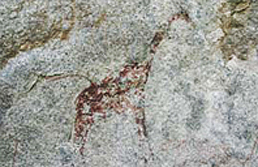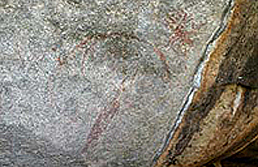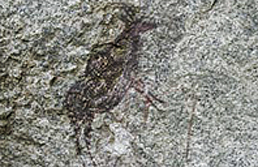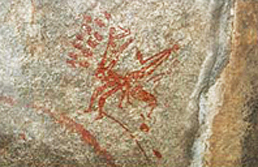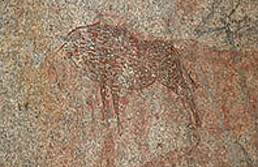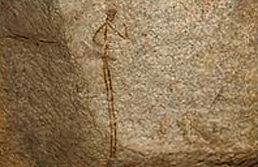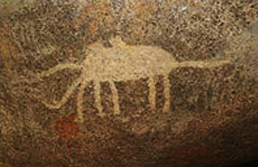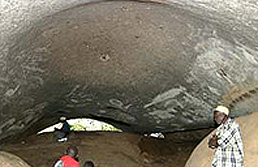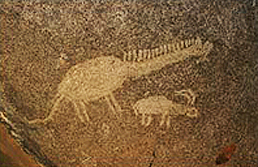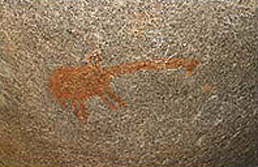 |
 |
Kipiti |
Site 7 |
Singida / Iramba District / Kinyangiri Division
On the other side of the valley and opposite Ntwiga hill, is a ridge locally known as Kipiti (hyena), and after which the site on the southern slopes is named. The subject matter of the paintings consists of animals, anthropomorphic figures, weapons such as bows and arrows and other ethnographic objects. There are also depictions of spheres or balls.
The animals are depicted in three different styles i.e. outline profile infilled with varying motifs, open-line outline without infilling, and boldly washed silhouettes. The anthropomorphic figures, though stylised, are depicted in two distinct styles. In some cases, they are depicted with some kind of attire, i.e. a loin cloth or some sort of a skirt made of reeds and appears to show anatomical lines, but in others the portrayals are simple line drawings with the head and the buttocks exaggerated. The heads have a crescentic shape.
The human figures with bows and arrows may be interpreted as depicting hunting, while dancing and other social behaviour may be inferred from seven human figures, three of which seem to be engaged in some social activity while the other four are presumably watching. It has also been suggested that the group of three figures standing close together and in the middle of the panel, represents a family; father, mother and child.
 |
 |
Kipuputi Iambi |
Site 8 |
Singida Region / Iramba District / Nduguti Division
Some 800m away from Kisimbu village and about 10m off the right side of Ishenga Iambi road is a rock shelter, which the people call Kipuputi. Brief examination of the rock shelter immediately revealed that it was once covered with paintings, but they are almost completely faded. As a result, it was not possible to identify any of the representations. The site is richly stratified with artifacts as manifested by several lithics on the surface.
 |
 |
Kirumi Isumbirira |
Site 9 |
Singida Region / Iramba District / Kisiriri Division
This site is a very impressive exterior cave, formed by a huge overhang supported by two boulders and extending almost to the ground level. It is a site that is well known and visited by local inhabitants from both Matongo and Kirumi and as such is relatively easy to find. The site was one of many rock painting sites visited and recorded by the Khol-Larsens in their ‘Deutsche Afrika-Expedition 1934-36’. They referred to it as Kirumiwand (Kohl-Larsen 1938: 35-36). In 1974, Masao excavated the site to study its possible use in prehistoric times and also to look for clues for dating (Masao 1979:74-91). In the absence of art mobilier, a direct clue for dating the rock art was not found.
Briefly, the site contains several silhouettes of animals and humans drawn mostly in white paint, but also in light brown or orange. The style of the white pigment figures is best described as a poor attempt at semi-naturalistic representation. Giraffes seem to have been the most popular subject of this style not only at this site, but also at others. Invariably, all the animals seem to have been drawn with exceptionally long necks while the feet are rather stumpy. The outline is generally fuzzy. The style differs so much from those executed in the red pigment that we can only surmise that we are viewing the art of different people from previously described sites. In cases of superposition, the white figures seem to overlie red paintings. Some light brown pigment has been used, but figures drawn in this pigment seem to be less exaggerated and definitely not as numerous as the white ones.
Not only is the site littered with lithics and pottery, but the 1974 excavations also revealed a continuous cultural sequence from historical times to deposits dated to 3.500 years BP. A slab of rock with white paint presummably of recent times and similar to that used in the pictographs was found lying on the floor but the local people of the area, the Wanyisanzu, deny knowledge of the paint and authorship of the paintings.Generally speaking, the site is still in a very good state of preservation despite many instances of the vandalistic ‘I was here’ syndrome. The highest painting is 3.2m from ground while the painted area is 8.3 x 4.3m.
→
Rock Art in Tanzania
→
Tanzania Rock Art - Forward by Dr. Meave Leakey
→
Overview of Tanzania Rock Art Sites
→
Tanzania Conservation & Management
→
Tanzania Rock Art Sites|
1-2 |
3-6 |
7-9 |
10-12 |
13-14 |
15-16 |
17-18 |
19-21 |
22-24 |
25-26 |
→
Africa Rock Art Archive
→
Bradshaw Foundation
Like us on Facebook & Follow us on Twitter to receive news & updates:
